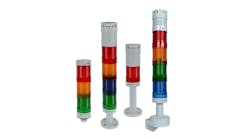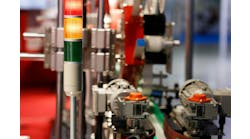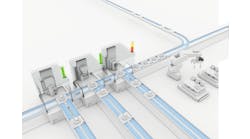Question: What sometimes makes you stomp on the gas, slam on the brakes or continue what you are doing? That would be a traffic stoplight or possibly a stack light on the manufacturing floor.
There are many ways to display status of a production system such as stack lights, Andon display boards, HMI terminals and illuminated pushbuttons. Each can give operation personnel a dynamic visual status of the manufacturing line and machine needs. However, none—at a glance—can indicate a machine's status or highlight the position of a fault or action needed better than a stack light mounted above the machine. It can provide a wealth of information, if implemented properly.
Looking down an aisle of a well-defined manufacturing space full of machines, how do you know what's running well? What about who's low on parts or where maintenance or a supervisor is needed? Each area, production line or system may have a dozen machines or more. Without stack lights on each machine, the sounds of production may be heard and operators and robots may be moving around, but it may not be clear where or when final products are being produced. It could just be a line of machines waiting at a stop sign or a road block.
Instead, consider walking to a manufacturing floor where each machine is required to have a stack light, well-positioned in line with other machines and with well-defined light functions. If green is good—a machine is running production—then with just a glance at a production line, a row of green illuminated lights allows management, manufacturing or maintenance personnel to quickly understand production, productivity and quality is doing well.
While green is good, adding some more light colors and some programming, a stack light can be loaded with information. While newer stack lights, with their advanced communication technology excel at changing color and flashing patterns, even the discrete-signal stack lights can provide a wealth of information by illuminating different colors, flashing and flashing at different rates.
It's important to remember that stack lights go the distance—the visual distance—while other methods are more local. An illuminated pushbutton or indicator may highlight a machine fault to an operator sitting or standing near a machine or control station. An HMI may also provide local indication of a problem. However, you need to be close to the indicator.
With a stack light, a machine status or a fault state is visible from a distance. Proper positioning of the stack light can extend viewing distance. If the operator's or supervisor's desk looks down an aisle in front of a row of machines, it doesn't make sense to have the stack lights mounted at the top rear corner of the machine.
There are many things in a manufacturing facility that can block the view of a stack light. A line of lights located toward the front side of a production line and all mounted at the same elevation, catches the eye as does any differences in color along that line.
The goal of any production line is to run. And, when it stops, it needs to quickly signal the appropriate personnel where to go to adjust the product, deliver parts or troubleshoot a problem. Stack lights, saving a little time, often, add to the bottom line.
To get instant help where and when it's needed takes more than just a well-thought-out installation of stack lights. Reliability is a must, so LEDs—preferably replaceable ones— are required. However, a careful definition of colors and the color position in consideration of the color blind are the starting points. The meaning of each illuminated solid or flashing color and its flashing rate must be clearly defined and consistent through out the plant. Here are some examples.
A constant-on red light can mean nothing other than a machine is stopped and/or faulted. An alarm horn, buzzer, chirp or bell—a unique sound to each area—can compel the personnel to look up at the stack lights, aiding awareness. The same red light flashing twice a second can indicate a critical, measured quality issue, and flashing eight times a second could indicate an operator is requesting a supervisor or other support immediately.
The yellow color of a stack light often indicates a warning condition such as an extended cycle time, parts are running low, a part bin is near full or a changeover is approaching.
Green is the color of money and should indicate a properly running machine. The light could also flash if a machine is available and/or ready to run. While flashing a light fast can often be irritating, it could also highlight the need to start the machine now for productivity's sake or when exceeding the required cycle rate.
Blue can indicate parts are needed, and flashing blue can indicate an offload is full and needs attention. Each light in the stack could be flashed in a Morse-code-like fashion where two flashes and a pause indicates Part A is needed, and three flashes and a pause indicates Part B is needed.
The basics define the functions of a stack light, and they should be consistent—but don't get too fancy.






